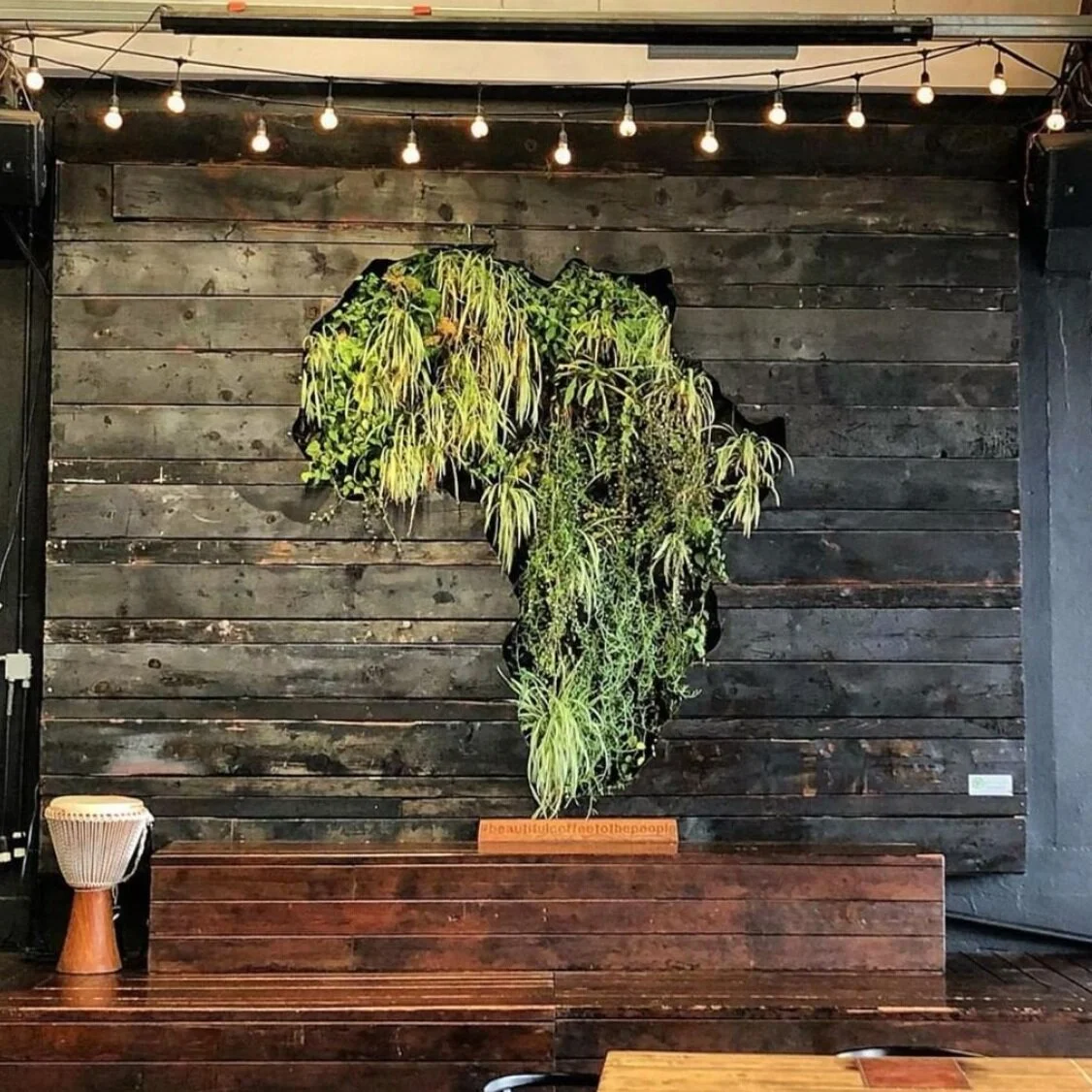Point of Origin Episode 28
Black Coffee
“I’m seeing more entrepreneurs of color getting into coffee. It’s a $50 billion industry per year and it’s not just baristas and roasters. It’s an enormous industry of technology, education, training, importing/exporting, compliance. There’s just such a vast array of career paths and opportunities, I’m just encouraging people to explore them.”
Keba Konte
Image Credit: JNP Coffee
Welcome back to Point of Origin. Today we are paying homage to coffee’s African coffee from East Africa to the East Bay. Artist turned coffee entrepreneur Keba Konte of Red Bay coffee discusses his journey to becoming a pioneering African American coffee roaster, as Keba says, the largest Black owned coffee company in the world. In Burundi, Jeanine Niyonzima-Aroian teaches us what makes Burundi an ideal coffee supplier. Finally, we chat with Doug Hewitt of 1951 Coffee in Oakland, California, a nonprofit organization providing job training for refugees. Today on Point of Origin, it’s Black Coffee.
Available on Apple Podcast, Spotify, & iHeartRadio
Highlights
( 00:00 ) Introduction
( 01:26 ) The Different Waves of Coffee
( 07:00 ) About Red Bay Coffee
( 10:15 ) Countries of Origin
( 13:40 ) JNP Coffee in Burundi with Jeanine Niyonzima-Aroian
( 15:25 ) The Process of Coffee Farming in Burundi
( 18:15 ) The Supply Chain of JNP Coffee
( 21:35 ) Coffee in Burundi from a Terroir Perspective
( 25:40 ) Politics of Land in Burundi
( 28:40 ) Making Coffee Sustainable
( 30:48 ) Talking with Doug Hewitt of 1951 Coffee
( 33:13 ) The Culture of Coffee
( 37:03 ) Closing Remarks from Stephen Satterfield
The Waves of Coffee
1st Wave
The first wave of coffee is seen as the commodification of coffee, with lower quality and transparency in their production process. It takes the form of a factory-like coffee with artificial flavoring, is super dark and bitter, and usually pre-ground.
Examples: Folgers, Green Mountain Coffee
2nd Wave
The second wave of coffee is highlighted by the experience of the coffee shop became more heightened, and there were more flavor options and drink styles. Bean origins became more transparent and there was more emphasis on higher quality drinks, but coffee was still generally dark and bitter.
Examples: Starbucks, Peet’s Coffee
3rd Wave
The third wave of coffee was focus on the coffee beans, and using a lighter roast. There was a much stronger focus on bringing out the nuanced flavors of the beans, and identifying the specific regions and farms where the beans were grown. Inside the cafés, the baristas were trained in latte art, and more manual brewing methods, like the french presses and pour overs.
Examples: Blue Bottle Coffee Company, Stumptown Roasters
4th Wave
The fourth wave is where we are today, with a commitment to coffee production that is not only high quality and sustainable, but also a vehicle for greater transparency, social and economic restoration, more diverse entrepreneurship, and environmental sustainability.
Examples: Red Bay Coffee
The Origins of Coffee
“Coffee started in Africa, Ethiopian to be specific. The more I was learning about the history of coffee and the origins of coffee, it just seemed to go against the grain of the popular misconception that coffee started in Italy or Seattle or Columbia or something.”
- Keba Konte
Most experts are certain that coffee originated from an Ethiopian plateau, but the story of how it was discovered is certainly up for interpretation. The most common myth references a goat farmer named Kaldi:
[ From the National Coffee Association, USA ]
Legend says the goat herder Kaldi first discovered the potential of these beloved beans. The story goes that that Kaldi discovered coffee after he noticed that after eating the berries from a certain tree, his goats became so energetic that they did not want to sleep at night.
Kaldi reported his findings to the abbot of the local monastery, who made a drink with the berries and found that it kept him alert through the long hours of evening prayer. The abbot shared his discovery with the other monks at the monastery, and knowledge of the energizing berries began to spread.
This legend did not appear in writing until 1671, and most of the accounts of this story date it back to 850. This seems to be the most popular story behind coffee’s origin, but it’s certainly not the only one. In Yemen, they have their own story that places describes a Yemenite Sufi mystic, Ghothul Akbar Nooruddin Abu al-Hasan al-Shadhili, traveling through Ethiopia and discovering a group of energetic birds eating fruit from the coffee plant. Tired from his journey, he tries the plant as well and discovers their energetic properties. (Sourced from The Spruce Eats)
While the precise origins of coffee remain unknown, its spread to other parts of the world and gain in popularity is well documented. Word of the drink moved east to the Arabian peninsula, and soon it took roots in the area. By the 15th century it was being grown in Arabia, and by the 16th century it had started to infiltrate the culture of many neighboring countries. Public coffee houses — called qahveh khaneh — began to appear in cities across the Near East.
JNP Coffee is a producer, exporter and importer of green coffee from Burundi that they promote in the global specialty coffee market. The company began in 2012, but their history with Burundi goes much further back. The founder, Jeanine Niyonzima-Aroian, is herself Burundian-born and raised. She left her home to attend a university in the United States.
Inspired by these deep ties to Burundi, JNP Coffee has built a successful business based on the quality potential of the coffees and the enterprising farmers who care for them. However, they define their success more broadly. The coffee growers in Burundi are their partners and they, too, share in the success.
The coffees that they source from the farmers of Burundi are exceptional. The climate, soil and people of East Africa are unique. Here many coffees grow as they always have, with no genetic modification, washed by fresh mineral-rich spring water.
The Coffee Production Process in Burundi
Image Credit: JNP Coffee
“When we talk about coffee that’s produced from Burundi, it’s very little compared to places like Brazil. Because of that, the opportunity to make coffee from Burundi very special and very unique is there.”
The coffee cherries are handpicked during harvest — no machinery is used, and the work is intensive
The cherries are delivered to the nearest mill — usually about an hour walk away
The cherries undergo a flotation process in water — to filter out the bad/good
The cherries go into a machine that removes the skin
The cherries soak overnight in tanks
The cherries are washed
For 30 days, the cherries are put on raised beds until they become dried out into a bean
They are brought to the dry mill for final processing
The coffee beans are exported
“It’s very labor intense, but because of the nature of the country being small, the labor is small compared to other countries. In my opinion this is a way to make sure that the coffee that comes from Burundi is made exceptionally well.”
What does fair trade really mean?
“In the ideal world for me, we need to look at a way to make this industry sustainable, encourage and bring the youth a long, empower women, because when we empower women more things can be done for the families and the communities. Also, incentivize quality and pay the farmers the right price.”
At JNP Coffee they always pay their farmers above and beyond the ‘Fair Trade’ price. According to Jeanine Niyonzima-Aroian, the Fair Trade Certification is a good starting point, but more needs to be done for the farmers who are doing such intensive work. Companies need to work hard to ensure that the farmers’ whose product they are buying are being compensated fairly for their tireless work.
As consumers and purchasers of coffee, it’s important to do your own research and use your money to make the change you want to see. Look into different companies purchase from those that best align with your values and wants for the future of the coffee industry. As Jeanine says:
“You just need to dig deeper. There are some great coffee companies out there who are doing the right things, but it’s really about doing your own research and getting educated about what companies are doing and which are aligned with your values.”
Red Bay Coffee Roasters was founded in 2014 by Keba Konte, a renowned artist and successful food entrepreneur with deep roots in the San Francisco Bay Area specialty coffee and hospitality industry.
1951 Coffee Company, founded in 2015, is a non-profit specialty coffee organization that promotes the well-being of the refugee community in the United States by providing job training and employment to refugees, asylees, and special immigrant visa holders while educating the surrounding community about refugee life and issues.
Our name is derived from the UNHCR’s 1951 Refugee Convention which first defined and set forth guidelines for the protection of refugees. In the spirit of this convention, 1951 Coffee works with refugees to help them overcome the unique barriers they face in seeking and sustaining employment.
Meet our Guests
About Keba Konte of Red Bay
Image Credit: https://www.redbaycoffee.com
Red Bay Coffee Roasters was founded in 2014 by Keba Konte, a renowned artist and successful food entrepreneur with deep roots in the San Francisco Bay Area specialty coffee and hospitality industry.
Red Bay Coffee is at the forefront of what we believe is the fourth wave of coffee—a firm commitment to ensure coffee production is not only high quality and sustainable, but a vehicle for diversity, inclusion, social and economic restoration, entrepreneurship, and environmental sustainability.
Red Bay seeks to create unity by hiring and serving people of all backgrounds, striving to be diverse and inclusive of those who have traditionally been left out of the specialty coffee industry, especially people of color, the formerly incarcerated, women and people with disabilities.
About Jeanine Niyonzima-Aroian of JNP COffee
Image Credit: JNP Coffee
As a child growing up in Burundi, Jeanine Niyonzima-Aroian recalls her mother telling the story of her entire family cultivating coffee in Ngozi Province to pay for school fees. Years later, Jeanine earned an MBA from Kellogg School of Management at Northwestern University and enjoyed a 20-plus-year international business career that led her back to Burundi and to coffee.
In 2012, Jeanine founded JNP Coffee. Jeanine is the only woman majority shareholder of a large Burundian coffee conglomerate – a role model for what a Burundian woman can achieve in her country. As a licensed Q grader, she continues to strengthen the global specialty coffee industry.
About Doug Hewitt of 1951 Coffee
Image Credit: https://www.1951coffee.com/our-team
Doug Hewitt started in the coffee industry in 2007 as a barista at Starbucks. In 2011 he began roasting at Boot Coffee Consulting on a project called Aleta Wondo Coffee. After a year of this, he switched to working in refugee resettlements. Three years, in 2015, Doug and Rachel Taber founded the 1951 Coffee Company.
1951 Coffee Company is a non-profit specialty coffee organization that promotes the well-being of the refugee community in the United States by providing job training and employment to refugees, asylees, and special immigrant visa holders while educating the surrounding community about refugee life and issues.
The name is derived from the UNHCR’s 1951 Refugee Convention which first defined and set forth guidelines for the protection of refugees. In the spirit of this convention, 1951 Coffee works with refugees to help them overcome the unique barriers they face in seeking and sustaining employment.












